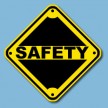Child Safety and Risk Reduction
Tips on child safety and risk reduction
There are no guarantees, by heightening your child’s sense of awareness and teaching sound defensive-strategies, the odds of becoming a victim can be reduced.
Risk Reduction
Risk reduction is the number one self-defense technique for not becoming a victim. Consider discussing the following child safety and risk reduction ideas with your children. In addition to discussing these Safety-Tips, you should try some simple role-playing scenarios with your child.
- Your full name.
- Your parents full names (especially if their last names are different).
- Your address.
- Phone number.
- Your birth date.
- Safe houses/Places to go to.
- Safe people (police and firemen, uniformed employees)
- Emergency phone numbers.
Discuss “STRANGER DANGER”
Bad people do not look a certain way and certainly don’t look like they do in the movies. Go over the following child safety and risk reduction pointers and use them as teaching points.
- Anyone can be a “Bad Person”.
- People you know can be “Bad People”.
- Listen to the “Little Voice” inside of you.
- Never go with a stranger.
- Never get near or into a stranger’s car.
- Never accept anything from a stranger (especially money, toys or candy).
- Don’t help people you don’t know (“lost puppy”).
- Don’t pose for a stranger who wants to take your picture.
- Don’t believe a stranger when they tell you that someone is hurt or go with a stranger (unless they use the correct SECURITY WORD).
AT HOME/PLAY-TIME
- Never play with fire or sharp objects.
- Always wear a helmet when bike riding or skateboarding.
- Never play by tying-up a playmate or being tied-up yourself.
- Never play with guns (leave if anyone wants to show you a gun).
- Play in safe areas – not near the street, under dark areas, behind cars, in driveways, in secluded
areas, or in abandoned cars or buildings. - Never play in a strangers house.
- Always let a parent know where you are and what the phone number there is.
- Lock doors and windows (at night or when home alone).
- Do not open the door to people you do not know – Use peep-holes or side windows (call the police if you don’t know the person at the door).
- Close shades and/or curtains.
- Keep lights at the doors on at night. If a light is out and someone knocks, be aware.
- Know a few phone numbers of neighbors.
- Have a written list of Emergency Numbers (Police, Fire, and Ambulance is 911, Doctors, Poison Control, Neighbors).
- If you have an alarm system learn how to use it.
- Ask “who’s calling” when you answer the phone – continue to ask or call a grown-up (or hang up).
- Never tell anyone you are home alone.
WHILE TRAVELING
- Always wear your seat belt.
- Keep your door locked while in the car.
- Never “play” with any control of a car.
- Look around before getting out of the car (for traffic dangers or suspicious looking people who
might be next to the car). - Never take short-cuts.
- Let people/parents know where you’re going and what route your taking.
- Stop, look, and listen before crossing any street.
- Try to walk in groups (the “Buddy System”).
- Know where the “Safe Houses/Places” are on your route (Police or Fire Station, Friends of Family, Store).
- Plan pick-up and Drop-Off places ahead of time (and repeat the information to be sure there is no mis-understandings).
- Don’t wear clothes or carry items that have your name on the outside.
WHAT TO DO
- If someone is following you don’t try to hide. Go to a safe place. If you have no other choice don’t be afraid to scream “HELP!”and continue to move away.
- If someone asks you for directions or help tell them “NO” while you are moving (running) away from them.
- Tell a parent if someone tells you to keep a secret from them.
- Tell a parent if someone threatens you or them.
- If you get lost or separated from your group in a store never go to the parking lot. Go to the cashier and tell them your lost.
FOR PARENTS
- Know your child’s friends.
- Never leave a child unattended.
- Spend some time at the activities your child is involved with – watch for proper supervision.
- Listen when your child says they don’t like someone (what’s the reason?).
- Notice anyone who is unusually attracted to your child.
- Note and write down any scars or birthmarks that your child might have.
- Have your child fingerprinted.
- Be aware of any radical changes in your child’s behavior/attitude.
- Talk to your child every day. Ask what happened (both good and not so good) during the day.
- Take frequent photographs of your child (4 times a year under the age of 2 years).
- Set up plans in case your child gets lost, is separated in a mall, finds no one home, and for the
other circumstances previously mention in the handout. If separated in a store notify an employee IMMEDIATELY. They probably have a store-plan. - Be sure of your child’s day care/school policy for releasing students under unusual circumstances.
- Talk to other parents about this information.
Balance these child safety and risk reduction “Safety Tips” without creating “Unrealistic Monster Fears” for your child.








